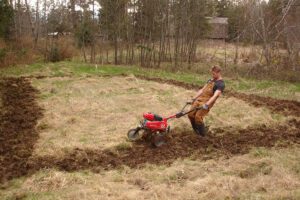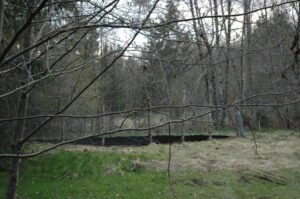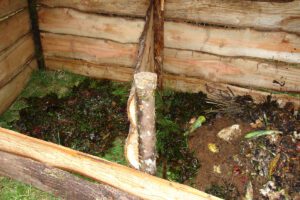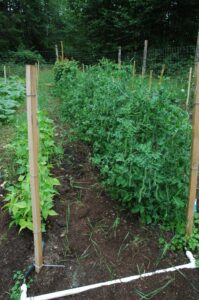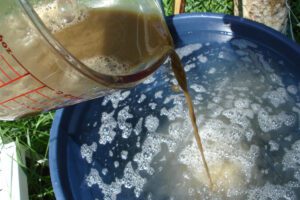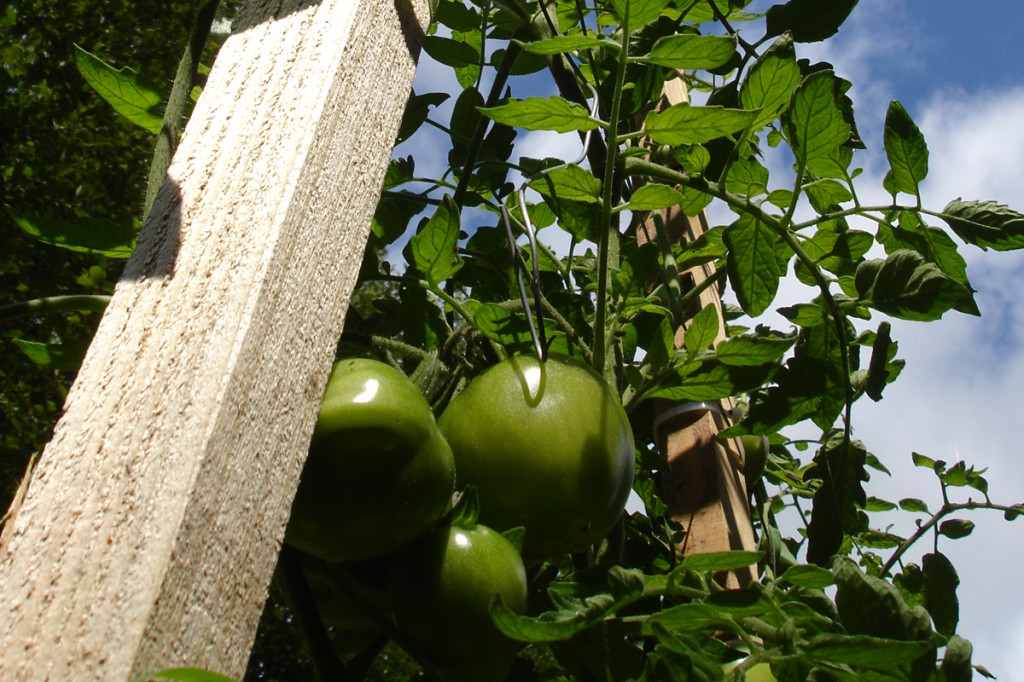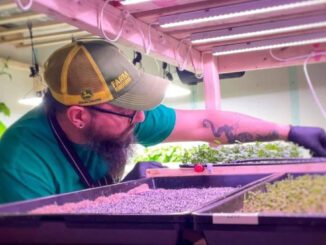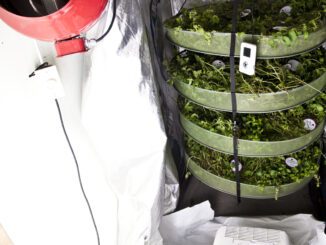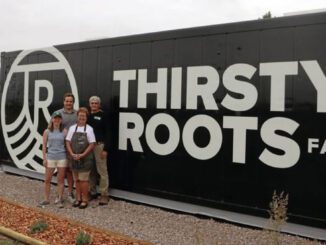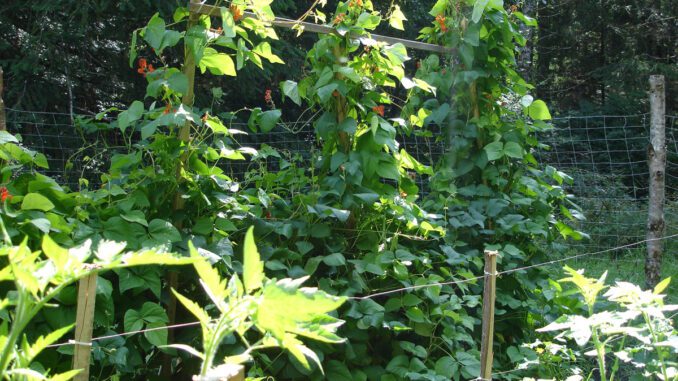
Organic Gardening Outdoors
A Time to Sow…
[quote]In organic gardening outdoors, the idea is to take advantage of the natural materials in the area.[/quote]
We now live in a day and age where people’s first experiences with growing may be indoors in an urban or sub-urban environment under artificial lighting. Many of the varieties grown indoors under lights may also be well suited to growing outdoors, given favourable climates. There are many strains that are difficult to grow indoors due to height at harvest, length of flowering, etc that can be grown outdoors on any scale under the open sky. So in these articles, the successful indoor grower might be enticed to leave the big city for fresher air, less traffic, and more importantly of course: unlimited cropping potential.
But, be prepared to pay for this unlimited cropping potential with the sweat off your brow. Organic gardening outdoors can be hard work! One of the key’s to success is to build a healthy soil environment for the roots of your favourite plants. The crop will also need to be protected from pests such as deer and rabbits. Don’t underestimate the will of critters that will raid your garden. If they are hungry, there is very little you can do to deter them, so physical barriers may be a requirement.
Your outdoor garden site needs to be selected carefully. You will likely want your garden to be out of the way of daily foot traffic but accessible so that you can supply water, if necessary, to the garden area and allow for materials to be taken in and out of the garden. A site with good soil conditions is preferred. If the natural soil is of marginal quality it can be improved, but for larger gardens this will mean much more labour. For most crops, the more exposure to sunlight the better. However, slightly sheltered areas help to protect the plants from winds and the partial shade they may receive for part of the day will help to reduce watering requirements in hotter and drier growing regions. Make sure that your garden site gets at least 6 hours of strong and direct sunlight per day, assuming you are growing high yielding and light loving plants.
Some gardeners prefer to keep their site blended in with the surrounding area for aesthetics purposes, as not to spoil the natural beauty of the landscape. In organic gardening outdoors, the idea is to take advantage of the natural materials in the area. This includes water sources, trees for building materials, native vegetation for composting, natural soil conditions, etc. When you use the natural materials surrounding your spot to create your gardening site, it is far less obtrusive on the eyes and landscape.
There will likely be some materials required that you will need to bring in from outside sources such as hoses, fence/netting, tools etc. It’s a very good idea to survey any potential spot and ask yourself how much work will be involved in preparation and how much materials you will need to bring in from outside sources. Beside for aesthetics purposes, using the natural materials surrounding your garden site will help save you money and reduce the amount of material handling involved. If your spot is in a remote area, you will need to make sure you will have everything you need available when you need it. In organic gardening outdoors, there are no quick trips down the street for goods like back in the concrete jungle. As clichéd as it may sound: “nobody plans to fail, but they fail to plan”.
Typically, when you grow outdoors, plants reach a much larger size by the time they reach maturity. Indoors, growth patterns for yields are more linear or “two dimensional”, where the top 2 or 3’ of the canopy is providing the most yield under artificial lighting sources. Outdoors, under natural light plants receive strong light levels from top to bottom, provided they are given adequate spacing between individual plants and rows. Consider how many plants you want to grow based on your desired yield and determine your spacing between plants and rows. If you plant later in the season, you can have higher planting densities and harvest the same as planting earlier in the season with fewer, but larger plants at harvest. Check with sources on seeds and plants to see what recommendations they have for plant spacing and approximate yields. If possible, plant more than you intend to harvest; nature can be cruel!
Once the number of plants and spacing requirements have been factored, you can begin to measure or stake out your garden plot for the size you will need. Take the time to select your site not only for location, but for the quality of the native soil.
Most soils will benefit from additions of materials by the grower, and for other soils it will be necessary to create a healthy soil environment for plant growth. To determine some of the characteristics of the native soil, dig a small hole to a depth of about 3’, being careful not to “mix” the dirt as you remove it. What you will see is what soil scientists refer to as “the soil profile”. Usually you will notice 3 or more distinct layers. Dark soils rich in organic matter are preferred, which usually occurs in the first layer of soil. As you go further down, rocks and clays become more prevalent. Clays, while very ‘hard” for roots to penetrate can be improved with sands, manures, and organic matter. Clay soils are usually higher in potassium, phosphorous and calcium which is advantageous if the texture can be improved. For productive outdoor gardens soils, there must be a balance between nutritional content and texture. A good soil texture drains well enough to prevent pooling of water on the surface and allows for the roots to penetrate through the soil. However it is not so fluffy that it will provide little mechanical support for large and heavy plants and will dry out too quickly in warmer conditions. Growers newer to outdoor cultivation may be astonished as to how much water a large plant can go through on a hot day. It is important that the soil is able to hold some levels of water in reserve as not to create a moisture deficit, which will stress plants and diminish yield potentials.
How well you want your garden to blend into the surrounding landscape will determine whether you till an entire area or prepare the soil on a per planting site basis (i.e “holes’). In nature, plants rarely grow in rows, but for the gardener it makes life easier for watering, fertilizing, supports, coverings, and adding ingredients to the soil, etc.
Rows will receive more sun if they are orientated North to South, as the sun rises in the East and sets in the West. If you decide to partially shelter your garden by taking advantage of native vegetation, etc, South-west exposure is excellent because the plants receive more ‘evening’ sun and avoid some of the peak hot hours during late morning and early afternoon.
Ideally, you should begin to prepare you garden site months before planting your crop. This allows time for biological activity in the soil to break-down organic materials which you may have added to improve the soil texture and to provide a full spectrum of organic and plant available nutrients. When actual plating time comes, you don’t want to have to do more than put your plants into the ground and double check your water source and delivery system. In areas that are drier in summer months but receive snow or rains during winter, construct and line pits that will capture some of the winter precipitation.
Now, when it comes to “breaking ground” the hard work really begins. A roto-tiller can simplify things, but when breaking virgin ground, especially where there are established native grasses, etc be prepared for a work-out. You may have to go over the plot several times before harder and more compacted soils begin to loosen. Roto-tillers are quite noisy and are heavy to move about. Make sure you have a means of easily transporting larger and heavier equipment in and out of the area.
The remote location organic gardener might take advantage of a pack mule to transport materials in and out of the garden and to help plough the soil. Designs for “animal powered” ploughs are hundreds of years old, and work just as well today. An additional benefit to pack mules, or other work animals is that the manure can be collected and composted for fertilizing in the garden. While this might sound strange to the Urban CEA Grower, some of the most experienced and successful Back Woods Gardeners this writer has interviewed discussed the use of “animal power” in large scale and remote garden sites. If you consider this as an option, make sure you are equipped and informed to care for your four-legged work force.
If selected carefully, certain types of healthy native soils are much easier to work by hand with shovels, hoes, picks, etc. If using a roto-tiller or ‘animal power” isn’t an option and you have tougher ground, planting in individual “holes” rather than a plot may be more advantageous.
While working the soil is the ideal time to mix or till in soil amendments. Compost is an excellent addition to any soil. Compost should be well aged, avoid “hot” composts as they are chemically less stable. Good quality composts will help to improve the soil texture and add many valuable nutrients and micro-organisms to your soil. Take advantage of native materials, and compost well in advance. In Western Canada kelps, foxtail, forest humus, and skunk cabbage are excellent “green manures” and are readily available. There are many articles available on composting, and it is worth while for the prospective outdoor cultivator to research methods and materials in composting. Remember that the Back Woods Gardener takes advantage of surrounding materials as best as possible. For example, kelp is full of naturally occurring trace elements and growth co-factors. Foxtail contains sources of silicate which helps to strengthen plant cells against insects, fungus and other diseases. This can be biologically digested through composting to make some very “yummy” stuff for your favourite plants.
However, don’t rely too heavily on delivering all of the nutrition for your plants through slow releases of organic matter. It is wise to provide a level of stable base nutrients through slow or intermediate release materials, but you can manage the changing nutritional requirements of your crop more precisely through liquid fertigations, which will be discussed in future installments in this series.
If possible, check the pH of your soil and adjust using dolomite lime or crushed oyster shells to raise the pH if necessary. Composts will help to acidify more basic (alkaline) soils as will ammonium sulphate. You can also get an idea of the type of soil you are working with by examining the native vegetation already growing there. Field guides and garden books will often describe the types of soil conditions that these plants are naturally found in.
Watering in or broadcasting beneficial inoculants and digestive enzymes such as trichoderma, mychorhizae, bacillus, glomus, etc while amending the soil with composts, worm castings, pH conditioners, etc will help speed up and improve the natural biological activity in the soil. This will help break down organic matter and convert it into nutrients and other substances beneficial to plants. Also, many of the species found in specialized fungal and bacterial inoculants will help improve resistance to diseases, insects, drought and frost. Certain species will also inoculate the roots of transplants once they are set into the garden.
After the soil has been worked and additions of organic amendments have been applied, you may need to construct a physical barrier surrounding the garden area. To prevent deer from devastating your crop a minimum of a 6’ high wire fence will be required. In some areas, deer are larger and more robust and can easily clear a 6’ tall fence. Make sure that the poles you use have some extra height, i.e. 8’ above grade for a 6’ tall fence. In this manner you can use runs of wire at the top to further deter pests from entering, and devastating your garden. Poles constructed out of native material blend into the landscape almost seamlessly, especially if you leave the bark on. For temporary gardens, you can just tack your wire fencing onto existing trees in the area. While this may not create a geometrically perfect area it will function to help keep problems out. Rabbits can also be problematic, especially with younger and more tender plants. Having a tighter mesh towards the bottom of your fence is a good idea, as a hungry rabbit will squirm through larger fence openings. Ideally about 6” at the bottom of the fence will be buried beneath grade in order to help discourage animals from tunneling in. Again, it is very important to discourage animals from entering the garden. Imagine returning to your garden mid-way through the season to find that it has been gnawed down to the ground by animal intruders.
This information should help the organic victory gardener get things started. These first few very necessary and important steps will keep you working very hard for the next little while. But, once you have your garden site selected, tilled, and amended things will get a little bit easier.

